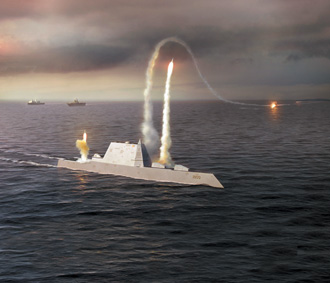Dual-Band Radar Illuminates New Missions
 |
The U.S. Navy’s Air and Missile Defense Radar (AMDR) will support its future warships such as the next-generation cruiser CG (X). Based on lessons learned developing the dual-band radar system for the Navy’s USS Zumwalt-class destroyers (pictured), the AMDR will combine an S- and an X-band radar into a single system. Unlike the Zumwalt’s radar, the AMDR will be capable of scanning the high atmosphere and low orbit to perform missile defense missions. |
An advanced radar being designed for the U.S. Navy would provide future warships with a powerful sensor capable of detecting and tracking a variety of threats, from ballistic missiles to aircraft and supersonic, sea-skimming anti-ship missiles. The new radar will combine the capabilities of two existing radars, resulting in fewer antennas on a ship’s superstructure, increased reaction time and the ability to adapt to changing combat environments rapidly. The system also will feature a modular plug-and-play architecture allowing quick system upgrades, more efficient use of hardware and bandwidth, and reduced power and cooling requirements.
The U.S. Navy’s Air and Missile Defense Radar (AMDR) is intended to equip the Navy’s future CG (X) cruiser and the as-yet undetermined Future Surface Combatant class of ships. The AMDR is a next-generation radar that will be designed to meet the Navy’s future ballistic missile defense, air defense and surface warfare requirements, explains Capt. Larry Creevy, USN, major program manager for above-water sensors at the U.S. Naval Sea Systems Command’s (NAVSEA’s) Integrated Warfare Systems 2.0 division,
The AMDR program is currently in its earliest stage. The Navy has launched studies with three contractors—Raytheon, Lockheed Martin and Northrop Grumman—that will incorporate their own feedback and suggestions about the service’s radar requirements. The studies are due by the end of this month. After the studies are collected and their suggestions incorporated, the Navy will launch a technology development phase followed by an engineering and manufacturing phase. The exact dates for these phases are still being worked out by the Navy, Capt. Creevy says. However, he expects that this program will follow the general timelines of previous radar development efforts.
Dual-band radar systems use digital beam forming technology to allocate groups of emitters to perform specific tasks such as tracking incoming targets. Dual-beam radar emitters consist of thousands of individual modules that can perform scan and illumination operations. Known as active arrays, these radars are more reliable than mechanically scanned systems because they do not have moving parts that are susceptible to damage and failure.
The AMDR will combine an X- and an S-band radar: the X-band for horizon search, precision tracking, missile communications and terminal illumination, and the S-band radar for volume search, tracking, ballistic missile defense discrimination and missile communications. Navy operational requirements also call for defense against low-altitude, low-observable threats in heavy land, sea and rain clutter. The radar’s specifications stipulate that it must switch rapidly between ballistic missile defense, air defense and surface warfare roles. Capt. Creevy notes that a radar suite controller will manage both radars in a coordinated manner. He explains that this dual-band and operational management capability differs from the S-band Aegis SPY systems currently equipping the fleet, which require a separate radar system for volume search. Dual-band, flexible systems are the ultimate operational design goal for future Navy radars, he says.
Most current warships use two different types of radars to scan large areas and for focused targeting. The data from these separate pieces of equipment is integrated in a ship’s combat system. Dual-band radars combine both sensor systems with the same electronics and software. This combination provides a ship’s combat system with a single data stream. The radar itself can mix its antennas to meet specific situational requirements. Aegis SPY radar systems use phased array antennas mounted on a ship’s superstructure. The latest versions of Aegis can search for and track more than 200 targets, and some versions have been modified to provide ballistic missile defense capability (SIGNAL Magazine, March 2008); however they still rely on separate secondary radar systems to perform some search functions, such as scanning for surface vessels.
Flexibility and scalability are to be part of the design. The AMDR will be built around modular software and hardware suites. Capt. Creevy explains that much of the design will be in open and nonproprietary systems, and the developers will conduct form fit functions over time as the technology matures. Industry partners will examine potential technology and module advances that will help the radar better fit into a variety of naval platforms, he says. The modular approach will allow interchangeability: as new capabilities are developed, new hardware will be able to be inserted with a minimum impact on the system. “We don’t want to have to keep reengineering this,” the captain says.
While the Navy’s current-generation Aegis SPY radar is a highly capable system, Aegis originally was not designed to operate as a ballistic missile defense system. By designing a ballistic missile tracking capability into the radar from the start of development, the AMDR will begin to demonstrate the next level of operational capabilities the service requires, Capt. Creevy says. Additional technical goals include developing a multifunction advanced active phased array radar with reduced power and cooling requirements.
 |
The AMDR will enable future warships such as the Navy’s CG (X) cruiser to track and engage a variety of targets from very low altitudes to the edge of space. |
The radar system will be designed to scale to support a variety of platforms. The captain notes that the Navy has asked the participating contractors for an initial concept design, a technology maturation schedule and technical specifications and requirements. He adds that these requirements are not necessarily tied to a specific hull or ship type.
Unlike the AMDR, with its ballistic missile tracking capability, the dual-band system slated for the DDG 1000-class ships is designed to track aircraft, missiles and incoming shore-based artillery. It does not have the power output for ballistic missile defense capabilities. But the dual-band radar that will be installed in the Zumwalt class destroyers and next-generation aircraft carriers such as the USS Gerald R. Ford shares many of the characteristics of the AMDR, specifically two different radar types for search and identification managed by a single radar control unit.
These new non-AMDR radar units also will rely on phased array antennas that conform to the ship’s superstructure to reduce the vessel’s radar signature and the radio frequency emissions issues caused by multiple antennas. Because of budget cuts, the Zumwalt class is limited to three ships, which restricts the number of platforms on which the ship’s radars can be deployed. The Navy is stressing flexibility for future platforms, and the current lack of a design for the CG (X) and the Future Surface Combatant is forcing designers to build flexibility into a system that must be scalable to accommodate current and future mission requirements.
WEB RESOURCES
PEO Integrated Warfare Systems: https://acquisition.navy.mil/rda/home/organizations/peos_drpms/peo_iws



Comments